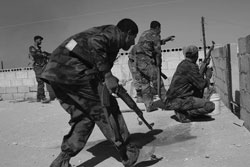Tensions between Russia and the West have been greatly exacerbated lately, with concerns of conflict on both sides becoming a dominant fear.
US intelligence agencies warned their European and NATO counterparts that the Russian Federation has deployed a force of roughly 94,000, with expectations of it massing to a soaringly high figure of 175,000. The deployment is concentrated in four main regions, including Russian-occupied Crimea. The Russian deployment includes 50 “tactical groups,” tank and artillery brigades, air assets, alongside the establishment of near border logistics depots and field hospitals. The latter deployments are of significant concern, as it differentiates this build up from the previous Russian military buildup this past Spring.
US Intelligence has also stated that it believes Russia will take military or destabilizing actions against Ukraine by January, with Ukrainian President Volodymyr Zelensky holding an alarming press conference earlier this month discussing how Ukrainian intelligence unveiled a coup attempt in the works amongst members of Ukraine’s oligarchy and interior ministry.
This past Wednesday, Russia accused Ukraine of deploying half of its military forces on the border of the Donbas, a region of Ukraine where armed conflict between the Ukrainian Government and Russian separatist rebels has been present since 2014. Substantial evidence is present that elements of the Russian military itself are also operating in the Donbas in support of the rebels.
Western reaction has been largely diplomatic. On Dec. 7, Russian President Vladimir Putin and US President Joseph Biden held a virtual meeting. As of writing, not too many details are known, however the Kremlin made it clear that no de-escalation concerning Ukraine was going to be possible. Regardless, Biden made it clear he was going to warn Putin on taking action against Ukraine, threatening harsh economic sanctions on top of pre-existing sanctions as a response. NATO, the military alliance between the US and several dozen European states, warned Russia of “serious consequences” in the event of any action taken against Ukraine.
In the background of all of this, the US State Department and Pentagon recently began investigating ways to evacuate US citizens out of Ukraine in the event of conflict, a step that is usually reserved for the direst of crises.
So, what has caused the sudden buildup on the Ukrainian border? The answer is not 100 percent clear, however there are a variety of factors that have contributed to Russian concerns over the status of Ukraine.
In the wake of the Euromaidan protests in 2014, where a pro-Russian government was ousted and a pro-West one installed, Russia took immediate action to secure its interests in Crimea via invasion and annexation, while also supporting the aforementioned ethnic Russian separatists who opposed the new government.
In more recent times, Ukraine has acquired US made Javelin anti-tank guided missile systems, alongside the Bayraktar TB2, a Turkish drone that Ukraine used against Donbas’ rebels last month.
While the weapon system acquisitions may be minor, it has caused concern in Russia that NATO could deploy more sophisticated systems in Ukraine, such as Aegis missile defense systems or offensive platforms such as ballistic missiles.
While these ideas have not been publicly entertained by the West, Russia would not wish to risk a miscalculation and allow further Western buildup on its immediate border. This can be seen as the rationale behind the Russian deployment, especially when taken into consideration Russia’s recent demands that NATO guarantee it will not expand eastward into Ukraine.
Many foreign policy experts in the West subscribe to the view that Russia sees Ukraine as a strategic buffer state between it and NATO – and therefore will take any means necessary to defend this arrangement.
The Ukrainian position on the matter is one of significant concern. Ukrainian officials can be quoted as saying that the Russian military buildup and exercises this past Spring were essentially a rehearsal of an action invasion.
On the topic of exercises, Russia and its ally Belarus, Ukraine’s northern neighbor, held military exercises this November and announced a new set of exercises slated to begin “in the medium term” roughly a week ago. The exercises will be held on the Belarusian-Ukrainian border.
The Ukrainian military has also prepared ad-hoc beach defenses in certain regions, however, these defenses consist of solely barbed wire and tank traps.
Overall, anxiety is prominent across Europe and its governments over what will happen in Ukraine. A conflict in the region has the potential to rapidly spiral out of control, while also destabilizing a region of the world that has seen relative peace since the end of the Second World War some seven decades ago.



